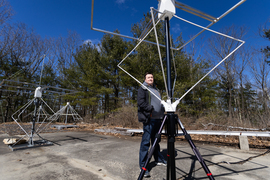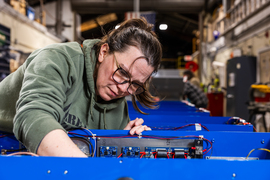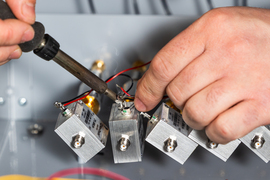On April 8, the moon’s shadow will sweep through North America, trailing a diagonal ribbon of momentary, midday darkness across parts of the continent. Those who happen to be within the “path of totality” will experience a total solar eclipse — a few eerie minutes when the sun, moon, and Earth align, such that the moon perfectly blocks out the sun.
The last solar eclipse to pass over the continental United States occurred in August 2017, when the moon’s shadow swept from Oregon down to South Carolina. This time, the moon will be closer to the Earth and will track a wider ribbon, from Mexico through Texas and on up into Maine and eastern Canada. The shadow will move across more populated regions than in 2017, and will completely block the sun for more than 31 million people who live in its path. The eclipse will also partly shade many more regions, giving much of the country a partial eclipse, depending on the local weather.
While many of us ready our eclipse-grade eyewear, scientists at MIT’s Haystack Observatory are preparing a constellation of instruments to study the eclipse and how it will affect the topmost layers of the atmosphere. In particular, they will be focused on the ionosphere — the atmosphere’s outermost layer where many satellites orbit. The ionosphere stretches from 50 to 400 miles above the Earth’s surface and is continually blasted by the sun’s extreme ultraviolet and X-ray radiation. This daily solar exposure ionizes gas molecules in the atmosphere, creating a charged sea of electrons and ions that shifts with changes in the sun’s energy.
As they did in 2017, Haystack researchers will study how the ionosphere responds before, during, and after the eclipse, as the sun’s radiation suddenly dips. With this year’s event, the scientists will be adding two new technologies to the mix, giving them a first opportunity to observe the eclipse’s effects at local, regional, and national scales. What they observe will help scientists better understand how the atmosphere reacts to other sudden changes in solar radiation, such as solar storms and flares.
Two lead members of Haystack’s eclipse effort are research scientists Larisa Goncharenko, who studies the physics of the ionosphere using measurements from multiple observational sources, and John Swoboda, who develops instruments to observe near-Earth space phenomena. While preparing for eclipse day, Goncharenko and Swoboda took a break to chat with MIT News about the ways in which they will be watching the event and what they hope to learn from Monday’s rare planetary alignment.
Q: There’s a lot of excitement around this solar eclipse. Before we dive into how you’ll be observing it, let’s take a step back to talk about what we know so far: How does a total eclipse affect the atmosphere?
Goncharenko: We know quite a bit. One of the largest effects is, as the moon’s shadow moves over part of the continent, we have a significant decrease in electron, or plasma, density in the ionosphere. The sun is an ionization source, and as soon as that source is removed, we have a decrease in electron density. So, we sort of have a hole in the ionosphere that moves behind the moon’s shadow.
During an eclipse, solar heating shuts off and it’s like a rapid sunset and sunrise, and we have significant cooling in the atmosphere. So, we have this cold area of low ionization, moving in latitude and longitude. And because of this change in temperature, you also have disturbances in the wind system that affect how plasma, or electrons in the ionosphere, are distributed. And these are changes on large scales.
From this cold area that follows totality, we also have different kinds of waves emanating. Like a boat moving on the water, you have bow shock waves moving from the shadow. These are waves in electron density. They are small perturbations but can cover really large areas. We saw similar waves in the 2017 eclipse. But every eclipse is different. So, we will be using this eclipse as a unique lab experiment. And we will be able to see changes in electron density, temperature, and winds in the upper atmosphere as the eclipse moves over the continental United States.
Q: How will you be seeing all this? What experiments will you be running to catch the eclipse and its effects on the atmosphere?
Swoboda: We’re going to measure local changes in the atmosphere and ionosphere using two new radar technologies. The first is Zephyr, which was developed by [Haystack research scientist] Ryan Volz. Zephyr looks at how meteors break up in our atmosphere. There are always little bits of sand that burn up in the Earth’s atmosphere, and when they burn up, they leave a trail of plasma that follows the wind patterns in the upper atmosphere. Zephyr sends out a signal that bounces off these plasma trails, so we can see how they are carried by winds moving at very high altitude. We will use Zephyr to observe how these winds in the upper atmosphere change during the eclipse.
The other radar system is EMVSIS [Electro-Magnetic Vector Sensor Ionospheric Sounder], which will measure the electron or plasma density and the bulk velocity of the charged particles in the ionosphere. Both these systems comprise a distributed array of transmitters and receivers that send and receive radio waves at various frequencies to do their measurements. Traditional ionospheric sounders require high-power transmitters and large towers on the order of hundreds of feet, and can cover an area the size of a football field. But we’ve developed a lower-power and physically smaller system, about the size of a refrigerator, and we’re deploying multiple of these systems around New England to make local and regional measurements.
Goncharenko: We will also make regional observations with two antennas at the Millstone Hill Geospace Facility [in Westford, Massachusetts]. One antenna is a fixed vertical antenna, 220 feet in diameter, that we can use to observe parameters in the ionosphere over a huge range of altitudes, from 90 to 1,000 kilometers above the ground. The other is a steerable antenna that’s 150 feet in diameter, which we can move to look what happens as far away as Florida and all the way to the central United States. We are planning to use both antennas to see changes during the eclipse.
We’ll also be processing data from a national network of almost 3,000 GNSS [Global Navigation Satellite System] receivers across the United States, and we’re installing new receivers in undersampled regions along the area of totality. These receivers will measure how the ionosphere’s electron content changes before, during, and after the eclipse.
One of the most exciting things is, this is the first time we’ll have all four of these technologies working together. Each of these technologies provides a unique point of view. And for me as a scientist, I feel like a little kid on Christmas Eve. You know great things are coming, and you know you’ll have new things to play with and new data to analyze.
Q: And speaking of what you’ll find, what do you expect to see from the measurements you collect?
Goncharenko: I expect to see the unexpected. It will be first time for us to look at the near-Earth space with a combination of four very different technologies at the same time and in the same geographic region. We expect higher sensitivity that translates into better resolution in time and space. Probing the upper atmosphere with a combination of these diagnostic tools will provide simultaneous observations we never had before — four-dimensional wind flow, electron density, ion temperature, plasma motion. We will observe how they change during the eclipse and study how and why changes in one area of the upper atmosphere are linked to perturbations in other areas in space and time.
Swoboda: We’re also sort of thinking longer term. What the eclipse is giving us is a chance to show what these technologies can do, and say, what if we could have these going all the time? We could run it as a sort of radar network for space weather, like how we monitor weather in the lower atmosphere. And we need to monitor space weather, because we have so much going on in the near-Earth space environment, with satellites launching all the time that are affected by space weather.
Goncharenko: We have a lot of space to study. The eclipse is just the highlight. But overall, these systems can produce more data to get a look at what happens in the upper atmosphere and ionosphere during other disturbances, such as storms and lightning periods, or coronal mass ejections and solar flares. And all of this is part of a large effort to build up our understanding of near-Earth space to meet demands of modern technological society.














